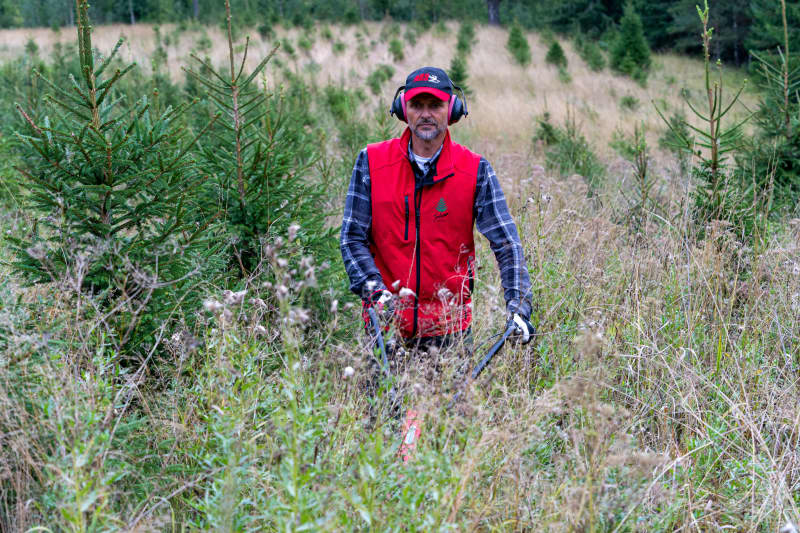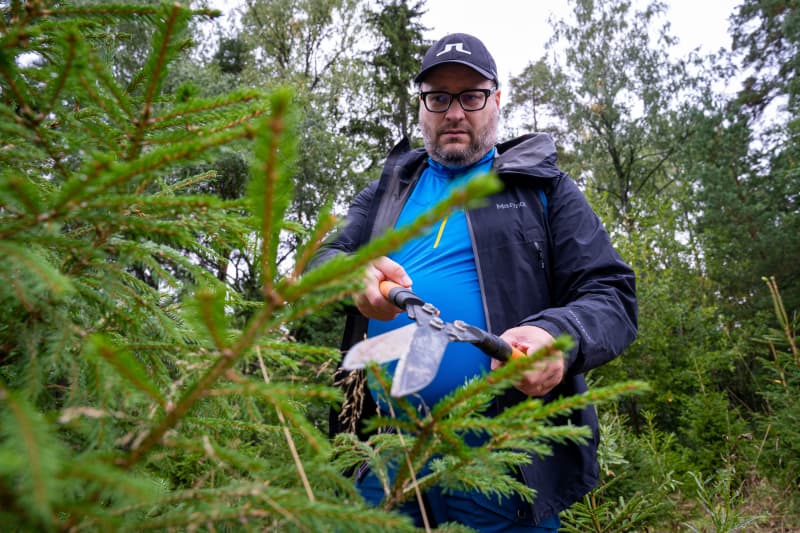Every Christmas, around one million Finnish households buy a Christmas tree. It takes about ten years from the time a Christmas tree plantation is established until the first harvest is ready for the season.
A dozen or so people listen to two speakers armed with a pair of penknives at the edge of a Salo forest. In front of them, a Christmas tree plantation opens up, with rows of trees of different lengths every couple of metres in neat rows.
Organised by the Forest Centre’s Well-being from Forest Livelihoods project, the aim of the tour is to learn about Christmas tree growing, and perhaps even convert a few visitors to the Christmas tree industry. This would come in handy.
The Christmas Tree Society is a national association of Christmas tree growers with around 200 members. Somerpalo estimates that there are more than four hundred Christmas tree growers in Finland.
For most of them, Christmas trees are a sideline, for example a project running alongside other forestry. According to Somerpalo, there are ten people in Finland who grow Christmas trees as a profession.
He is a forest engineer himself, who has worked in the forestry sector for a long time. Growing Christmas trees as a sideline has been around for twenty years. For an enthusiastic forester like Somerpalo, Christmas trees are just as much a side income, but also a hobby.

Whereas in forest management one area is taken care of at a time, in growing a Christmas tree one tree is taken care of at a time.
– You can almost recognize the trees in your plantation by their appearance, they almost become friends, Somerpalo laughs.
There is a reason for taking care of an individual spruce: the idea is to get the branches of the spruce as beautiful as possible by cutting the shape and density of the tree. The more idyllic a Christmas tree is created by trimming it into a cone shape, the more likely it is to be bought to decorate the living room.
A beautiful Christmas tree is the result of a lot of hard work
The most suitable area for Christmas trees is a field-like, well-drained, gently sloping slope.
– Good road transport connections and a location close to the farmer are also important. You should be able to get to the area with your own car whenever you need to, chairman Juha Ruuska says.
The most common cultivated variety is forest fir, but there are also, for example, Serbian oak and October oak. Planting of seedlings often takes place in May. During the summer, you should clean the grass away from the base of the fir trees, so that the undergrowth does not bend them into an ugly shape or make them one-sided.
Spruce trees should start trimming when they are over a meter long. Pruning shears have to be used several times a year, and even with a small crop this can take time. A quick snap to a conical shape, and moving on to the next tree. Otherwise, it takes forever to be busy, the Christmas tree club knows.

Spruce takes ten years to grow to two meters, unless pests, diseases or bad weather play tricks on it. When a good length of 2-3 meters has been reached, the spruces are collected about a month before Christmas. After that, there is melting of the frozen trees, watering of the spruce and preparation for sale with final trimming.
– Some are sold by themselves, some are sold to retailers. Things are handled in such a way that the days of Christmas can be spent in peace, chairman Juha Ruuska says.
Finns prefer a domestic Christmas tree
About one million Finnish households buy a domestic Christmas tree every year. About 150,000 trees are bought imported from abroad, most of them come from Denmark, which is a big country in the Christmas tree industry. 300,000 procure spruce from their own forest.
At markets and store parking lots, it’s time for Christmas tree growers to take stock.
– For many, this is about an interest in growing spruce trees, but of course the economy is important, because time passes and the equipment alone costs money, says vice-president Somerpalo.
The best area for Christmas tree sales is in southern Finland, where you can get around 30–50 euros for a fir tree. A seedling costs about 50 cents, so the cover is excellent in itself. However, there will be waste, and an important skill is to know how to estimate the number of fir trees to be sold. Most of the sellers sell less than one hundred to five hundred Decembers a year.
– For me, the sale of fir trees brings a nice addition to the Christmas party, I rarely get packages under a fir tree, says Somerpalo.

– About ten years ago, I bought a book about this upbringing. There are a few small forest plots where this could be a nice hobby on a small scale.
Kuikka is particularly interested in the Christmas tree’s inflation protection. Kuikka believes that as the value of other timber varies, small-scale Christmas tree growing would have a predictable economic future.
– If you were to buy a couple of boxes of spruce seedlings and try them, you would put them in grandma’s old field. It would be like staying in the forest, and the money isn’t a bad thing either, Kuikka reflects.
Even though it’s small-scale, Kuikka still recognizes the risks of the hobby. As Ruuska and Somerpalo of the Christmas Tree Club warned during the introductory speeches, a prick from a Christmas tree needle can take you with you.

